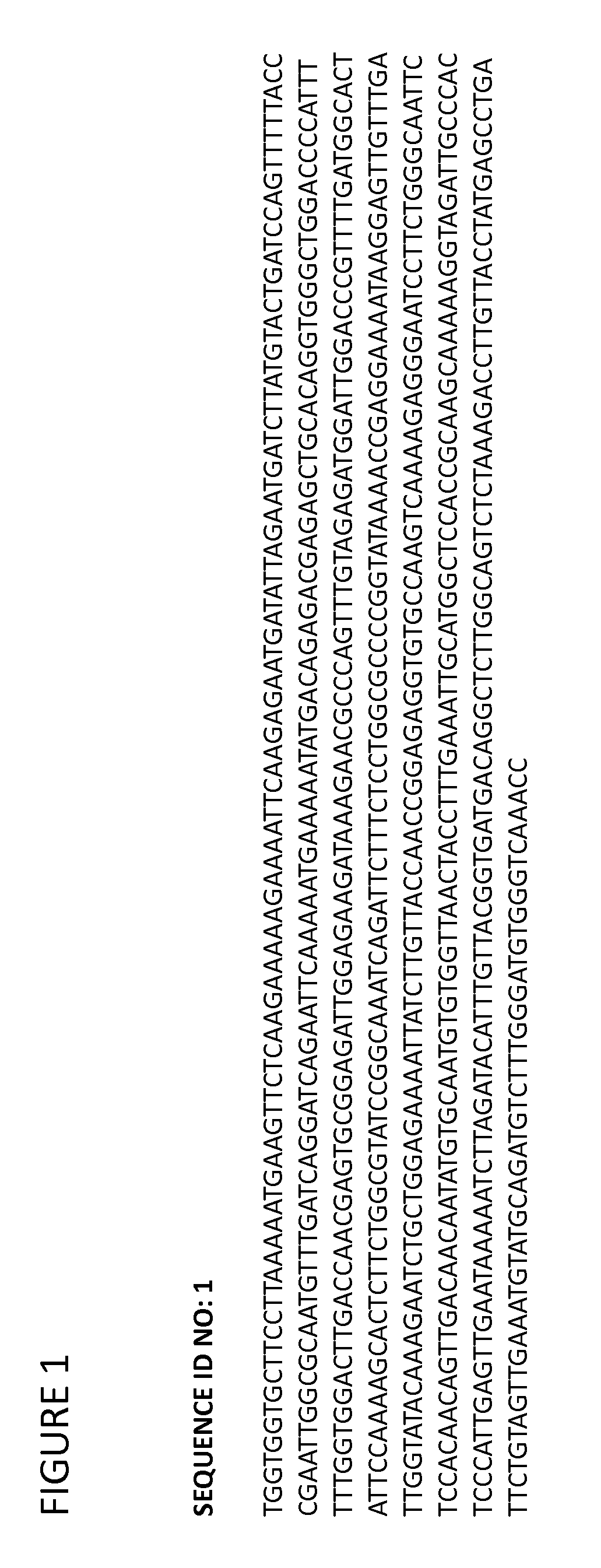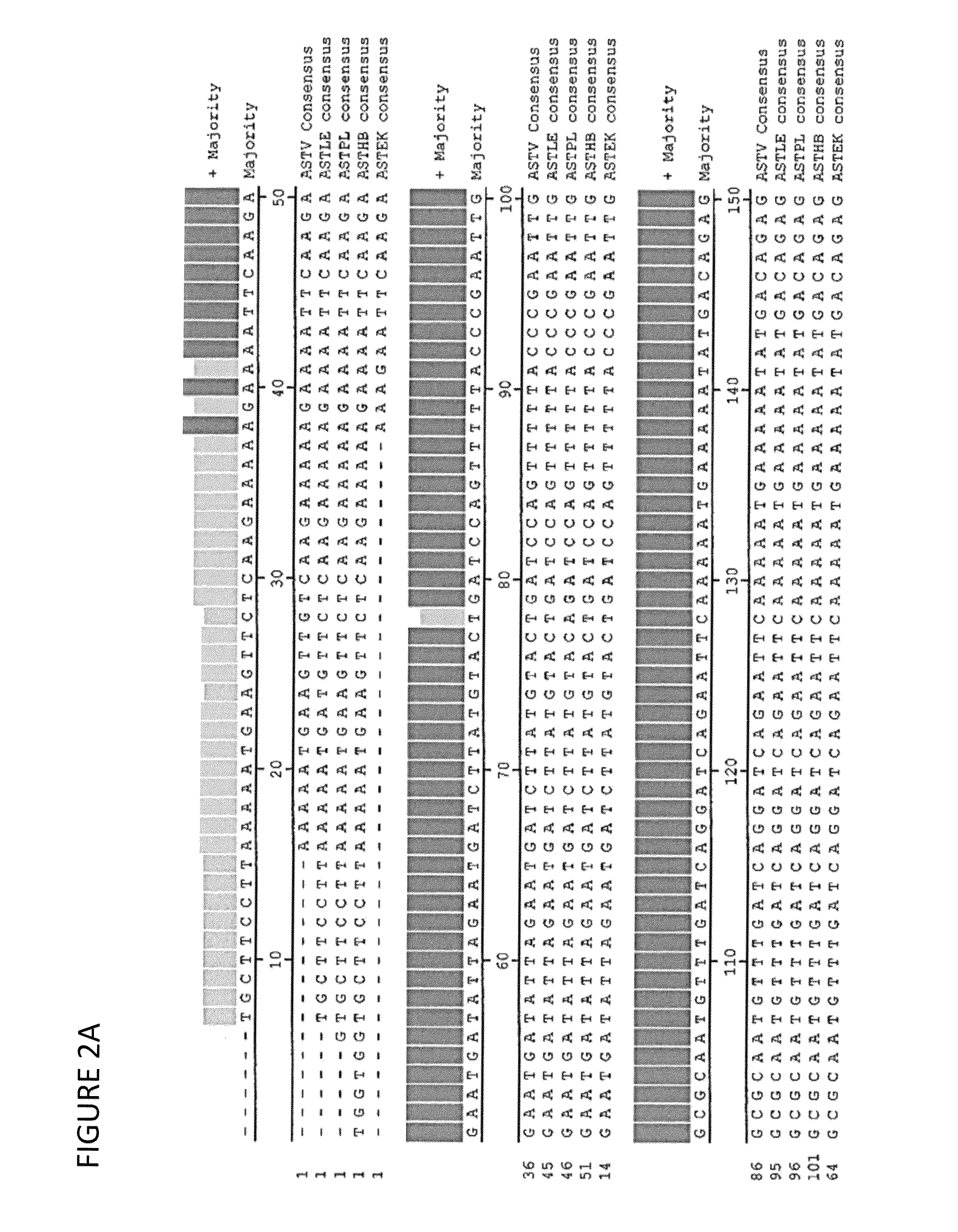Astrovirus
a technology of astrovirus and astrovirus, which is applied in the field of new avian astrovirus, can solve the problems of mas, which is still a major problem, and the mas is not fully established
- Summary
- Abstract
- Description
- Claims
- Application Information
AI Technical Summary
Benefits of technology
Problems solved by technology
Method used
Image
Examples
example 1
Isolation of Astroviruses
[0073]The novel astrovirus serotype disclosed herein has been isolated from several infected chickens, West Virginia, USA. The astroviruses were cultivated in an adapted hepatocellular carcinoma cell line (CH-SAH, which is alternatively called the LMH cell line). The original LMH cell line was obtained from the American Type Culture Collection (ATCC), accession number ATCC CRL 2117 and has been adapted to be non-collagen dependent.
example 2
Amplification of Partial Sequence of Astrovirus Isolate AVS-1 and Comparison to Other Isolates from Similar Clinical Cases
[0074]The viral RNA was extracted by TRI reagent (Sigma) according to the manufacturer instructions. Reverse transcription was performed for 60 min at 37° C. in 25 μl standard reaction mixes containing MMLV-reverse transcriptase (Promega) and random hexamer. The primers covered the most conserved region of the polymerase gene (ORF1b) from 3544 to 4235 nt as displayed in FIG. 4. The external primers amplified a 691 bp PCR product (forward AstPol1: 5′-CCA CTT TGG TGG TGC TT-3′ (SEQ ID NO: 2), reverse AstPol2: 5′-GGT TTG ACC CAC ATC CCA A-3′ (SEQ ID NO: 3)). The PCR reaction was carried out on 5 μl of samples from cDNA as template in the presence of 75 μM of each dNTPs, 0.2 μM of each primers, 2U Tag polymerase (Fermentas) and 2.5 mM MgCl2. The PCR program was: initial denaturation at 94° C. for 1 min, 35 cycles at 94° C. for 30 sec, 50° C. for 30 sec, 72° C. for 1 ...
example 3
Efficacy of Inactivated Astrovirus Vaccine
[0076]Progeny chicks from breeder hens that were vaccinated four times with an inactivated astrovirus vaccine were challenged with astrovirus to evaluate the efficacy of the vaccine. The vaccine was made by inactivating AVS-1 with 0.2% formalin (final concentration) and adjuvanted with an oil based adjuvant. Specific pathogen free (SPF) chickens were vaccinated subcutaneously two times with 0.5 ml of the inactivated astrovirus vaccine at 2 and 21 weeks of age. The chickens were bled at 2, 4 and 8 weeks post the 1st vaccination and at 3 weeks post the 2nd vaccination. Collected sera were used for the VN test using AVS-1 antigen to monitor development of neutralizing antibodies against astrovirus. Progeny chickens from the vaccinated chickens were also bled at hatch to monitor maternally transferred antibodies in the progeny. Eggs were collected twice, between 3 and 4 weeks after the 2nd vaccination and between 4 and 5 weeks after the 2nd vacc...
PUM
| Property | Measurement | Unit |
|---|---|---|
| diameter | aaaaa | aaaaa |
| temperatures | aaaaa | aaaaa |
| temperature | aaaaa | aaaaa |
Abstract
Description
Claims
Application Information
 Login to View More
Login to View More - R&D
- Intellectual Property
- Life Sciences
- Materials
- Tech Scout
- Unparalleled Data Quality
- Higher Quality Content
- 60% Fewer Hallucinations
Browse by: Latest US Patents, China's latest patents, Technical Efficacy Thesaurus, Application Domain, Technology Topic, Popular Technical Reports.
© 2025 PatSnap. All rights reserved.Legal|Privacy policy|Modern Slavery Act Transparency Statement|Sitemap|About US| Contact US: help@patsnap.com



